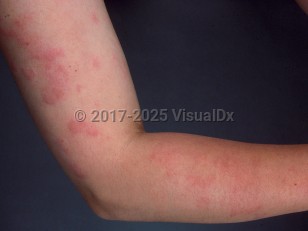Urticaria can be triggered by a variety of mechanisms, both allergic and nonallergic. Urticaria is categorized as acute (new-onset or recurring episodes of up to 6 weeks' duration) or chronic (recurring episodes lasting longer than 6 weeks).
In half of acute urticaria cases, the inciting factor is never identified; 40% of cases are associated with an upper respiratory infection, 9% with drugs, and 1% with foods. Drugs causing acute urticaria include NSAIDs, radiocontrast media, opiates, and angiotensin-converting enzyme (ACE) inhibitors.
Chronic urticaria is more common in women and individuals aged 40 years and older, whereas acute urticaria is more commonly seen in children. The disease resolves within 2 years in approximately 50% of individuals with chronic urticaria; however, 20% of individuals may have symptoms that persist for more than 10 years. Chronic urticaria is subdivided into chronic inducible urticaria and chronic spontaneous urticaria, based on whether definite triggers exist and can be identified. Chronic inducible urticaria is triggered consistently, reproducibly, and exclusively by a specific stimulus. These stimuli further define chronic inducible urticaria subtypes: symptomatic dermographism, cold urticaria, delayed pressure urticaria, solar urticaria, heat urticaria, and vibratory angioedema are physical urticarias, whereas cholinergic urticaria, contact urticaria, aquagenic urticaria, and adrenergic urticaria are not.
Chronic spontaneous urticaria may be exacerbated by triggers such as NSAIDs, alcohol, and stress, but triggers are not definite, as stimuli do not always produce symptoms. While the cause of chronic spontaneous urticaria is unknown, the presence of mast cell-activating autoantibodies in many patients raises the possibility of an autoimmune origin. It is also associated with other autoimmune conditions, including autoimmune thyroid disease, vitiligo, type 1 diabetes mellitus, rheumatoid arthritis, and autoimmune gastritis.
Other associated factors:
- Acute urticaria – high population density, allergic disease
- Chronic urticaria – hepatitis B virus, hepatitis C virus, Epstein-Barr virus, mycoplasma, systemic lupus erythematosus, neoplasms (especially lymphoreticular cancers and lymphoproliferative cancers), and oral contraceptive pills (OCPs)
- Chronic induced urticaria – environment (temperature, altitude), allergic disease
- Chronic spontaneous urticaria – gastrointestinal tract infection (Helicobacter pylori, bowel parasites) and inflammation (gastritis, reflux esophagitis, cholangitis), bacterial infection of the nasopharynx, cancer, depression, anxiety, and metabolic syndrome
- Vibratory urticaria – mutation in ADGRE2 (EMR2), which affects mast cell function



 Patient Information for
Patient Information for 
